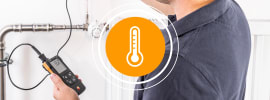Pasteurization: What you need to know
The safety of food is taken for granted by consumers. The preservation of food via the process of pasteurization in autoclave pots, full-water immersion or shower type autoclaves or retorts is essential for this.

Inactivation of pathogenic germs to increase food shelf-life with complete preservation of nutrients via a core temperature of between 60 °C and 100 °C
Systems should be validated once a year
Aufwärmphase
Die Wassertemperatur wird in einem Topfautoklaven auf die zuvor definierte Pasteurisierungstemperatur von beispielsweise +95 °C gebracht.Pasteurisierung
Die Pasteurisierungstemperatur wird in der gesamten Anlage erreicht und es herrscht eine homogene Temperaturverteilung. Die Prozessdauer und Pasteurisierungstemperatur variieren je nach Produkt.Abkühlphase
Das Produkt wird aus dem Topfautoklaven entfernt und auf Raumtemperatur gebracht. Je nach Produkt und Anlagentyp ist eine Clean-in-Place-Reinigung (CIP) notwendig, um die Bildung von Mikroorganismen in der Anlage zu vermeiden.
Checking and regular verification as to whether the pasteurization process is effective
Determination of the correct hold times/pasteurization temperatures and the P-value
Measurement of temperatures at the coldest point in the process
Correct placement of the data logger is crucial for ensuring the reliable killing of germs in the product
HACCP
testo 191 HACCP data logger system consisting of HACCP data loggers, software and multifunction case
Measuring range -50 to +140 °C
Small battery for placement in small containers
A wide range of accessories allows optimal positioning of loggers for the core temperature measurement
Simple calculation of P-value and holding phase by the software

How can our data logger systems help you specifically?
Contact
The right data logger system for your pasteurization processes
The testo 191 HACCP data logger system

Downloads for the testo 191 HACCP data logger system
Whitepapers, application examples, product brochures, and fact sheet












































